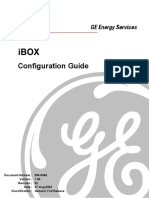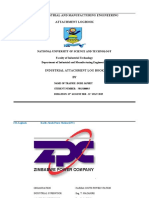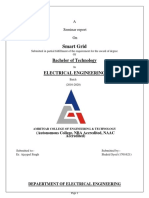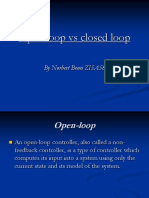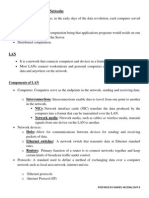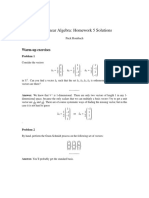0 ratings0% found this document useful (0 votes)
219 viewsEE462 Design of Digital Control Systems PDF
EE462 Design of Digital Control Systems PDF
Uploaded by
Arya RahulThis document outlines an undergraduate course on digital control systems. The course introduces digital control concepts and design strategies over 6 modules. Students will learn to design digital PID controllers, compensators using frequency response and root locus methods, and state-space controllers. Assessment includes 2 internal exams and an end semester exam testing knowledge across all modules. The course aims to equip students with the ability to design, analyze, and ensure stability in digital control systems.
Copyright:
© All Rights Reserved
Available Formats
Download as PDF, TXT or read online from Scribd
EE462 Design of Digital Control Systems PDF
EE462 Design of Digital Control Systems PDF
Uploaded by
Arya Rahul0 ratings0% found this document useful (0 votes)
219 views2 pagesThis document outlines an undergraduate course on digital control systems. The course introduces digital control concepts and design strategies over 6 modules. Students will learn to design digital PID controllers, compensators using frequency response and root locus methods, and state-space controllers. Assessment includes 2 internal exams and an end semester exam testing knowledge across all modules. The course aims to equip students with the ability to design, analyze, and ensure stability in digital control systems.
Original Title
EE462 Design of Digital Control Systems.pdf
Copyright
© © All Rights Reserved
Available Formats
PDF, TXT or read online from Scribd
Share this document
Did you find this document useful?
Is this content inappropriate?
This document outlines an undergraduate course on digital control systems. The course introduces digital control concepts and design strategies over 6 modules. Students will learn to design digital PID controllers, compensators using frequency response and root locus methods, and state-space controllers. Assessment includes 2 internal exams and an end semester exam testing knowledge across all modules. The course aims to equip students with the ability to design, analyze, and ensure stability in digital control systems.
Copyright:
© All Rights Reserved
Available Formats
Download as PDF, TXT or read online from Scribd
Download as pdf or txt
0 ratings0% found this document useful (0 votes)
219 views2 pagesEE462 Design of Digital Control Systems PDF
EE462 Design of Digital Control Systems PDF
Uploaded by
Arya RahulThis document outlines an undergraduate course on digital control systems. The course introduces digital control concepts and design strategies over 6 modules. Students will learn to design digital PID controllers, compensators using frequency response and root locus methods, and state-space controllers. Assessment includes 2 internal exams and an end semester exam testing knowledge across all modules. The course aims to equip students with the ability to design, analyze, and ensure stability in digital control systems.
Copyright:
© All Rights Reserved
Available Formats
Download as PDF, TXT or read online from Scribd
Download as pdf or txt
You are on page 1of 2
Course Name L-T-P -Credits Year of
Course code Introduction
EE462 Design of Digital Control Systems 3-0-0-3 2016
Prerequisite: Nil
Course Objectives
To introduce the need and concept of digital control system.
To impart knowledge about different strategies adopted in the design of digital controllers.
To familiarize with the design of different types of digital controllers.
Syllabus
Basic digital control system-Pulse transfer function-Digital PID controller design- compensator
design using frequency response - compensator design using root locus - Direct design-method of
Ragazzini - Dead-beat controller design - State space analysis and controller design.
Expected outcome.
On successful completion, the students will have the ability to
i. design digital controllers.
ii. analyse discrete time system using state space methods.
iii. analyse the stability of discrete time system.
Text Books:
1. Benjamin C. Kuo, Digital Control Systems, 2/e, Saunders College Publishing, Philadelphia,
1992.
2. C. L. Philips, H. T. Nagle, Digital Control Systems, Prentice-Hall, Englewood Cliffs, New
Jersey, 1995.
3. M. Gopal, Digital Control and State Variable Methods, Tata McGraw-Hill, 1997
4. Ogata K., Discrete-Time Control Systems, Pearson Education, Asia.
References:
1. Constantine H. Houpis and Gary B. Lamont, Digital Control Systems Theory, Hardware
Software, McGraw Hill Book Company, 1985.
2. Isermann R., Digital Control Systems, Fundamentals, Deterministic Control, V. I, 2/e, Springer
Verlag, 1989.
3. Liegh J. R., Applied Digital Control, Rinchart & Winston Inc., New Delhi.
Course Plan
Sem.
Module Contents Hours Exam
Marks
Basic digital control system- Examples - mathematical model-ZOH and
I FOH- choice of sampling rate-principles of discretization - Mapping between 7 15%
s-domain and z-domain
Pulse transfer function- Different configurations for the design- Modified z-
II transform-Time responses of discrete data systems-Steady state 7 15%
performance.
FIRST INTERNAL EXAMINATION
Digital PID and Compensator Design: Design of digital PID controller, Design
III 7 15%
of lag, lead compensators - based on frequency response method.
Digital Controller Design: Design based on root locus in the z-plane, direct
IV design - method of Ragazzini. Dead-beat response design- Deadbeat 7 15%
controller.
SECOND INTERNAL EXAMINATION
State variable model of discrete data systems -Various canonical form
representations-controllable, observable, diagonal and Jordan forms-
V 7 20%
Conversion from state space to transfer function -Computation of state
transition matrix using Cayley-Hamilton theorem and z-transform method
Digital state feedback controller design: Complete state and output
Controllability, Observability, stabilizability and reachability - Loss of
VI 7 20%
controllability and observability due to sampling.Pole placement design using
state feedback for SISO systems.
END SEMESTER EXAM
QUESTION PAPER PATTERN:
Maximum Marks: 100 Exam Duration: 3Hourrs.
Part A: 8 compulsory questions.
One question from each module of Modules I - IV; and two each from Module V & VI.
Student has to answer all questions. (8 x5)=40
Part B: 3 questions uniformly covering Modules I & II. Student has to answer any 2 from the 3
questions: (2 x 10) =20. Each question can have maximum of 4 sub questions (a,b,c,d), if needed.
Part C: 3 questions uniformly covering Modules III & IV. Student has to answer any 2 from the 3
questions: (2 x 10) =20. Each question can have maximum of 4 sub questions (a,b,c,d), if needed.
Part D: 3 questions uniformly covering Modules V & VI. Student has to answer any 2 from the 3
questions: (2 x 10) =20. Each question can have maximum of 4 sub questions (a,b,c,d), if needed.
You might also like
- Marketplace: System Requirements Specification (SRS)Document60 pagesMarketplace: System Requirements Specification (SRS)Alex100% (1)
- EIT Course Substation Design Control Protection Facility Planning CEY2 BrochureDocument4 pagesEIT Course Substation Design Control Protection Facility Planning CEY2 Brochuregendoabdoul120No ratings yet
- M4864P6B Module Specification: Revision History Date Prepared by DetailsDocument5 pagesM4864P6B Module Specification: Revision History Date Prepared by DetailsSatheesh Kumar NatarajanNo ratings yet
- Electromagnetic Compatibility of Industrial Networks and FieldbusesDocument38 pagesElectromagnetic Compatibility of Industrial Networks and FieldbusesCarlos ChocobarNo ratings yet
- Gpdk180 DRMDocument313 pagesGpdk180 DRMvpsampathNo ratings yet
- ECE 3300 Exam 4 Notes SheetDocument3 pagesECE 3300 Exam 4 Notes Sheetr3cebarnett100% (1)
- QuickBooks Intro Course GlossaryDocument9 pagesQuickBooks Intro Course GlossaryGaylin Read100% (1)
- BACnet ExamplesDocument5 pagesBACnet Examplesbenditasea3352No ratings yet
- Microprocessor-Based/Ddc Fundamentals: Chapter 4 Bms (DDC Control Fundamental)Document31 pagesMicroprocessor-Based/Ddc Fundamentals: Chapter 4 Bms (DDC Control Fundamental)skywalker_handsomeNo ratings yet
- ITU RecommendationsDocument25 pagesITU Recommendationscoolbuddy_2k4No ratings yet
- HD - 5.6 Schedule of Electrical RequirementsDocument83 pagesHD - 5.6 Schedule of Electrical RequirementsGajendra SinghNo ratings yet
- Normal ChecklistDocument2 pagesNormal ChecklistNacho ConsolaniNo ratings yet
- 1 IntroductionDocument21 pages1 IntroductionWajiha ZahraNo ratings yet
- Micom P40 Agile: Grid SolutionsDocument12 pagesMicom P40 Agile: Grid SolutionsAdetunji TaiwoNo ratings yet
- The Relative Gain For Non-Square Multivariable Systems - Chang1990 PDFDocument15 pagesThe Relative Gain For Non-Square Multivariable Systems - Chang1990 PDFHesam AhmadianNo ratings yet
- LV SWBD Design ProblemDocument15 pagesLV SWBD Design ProblemkggganiNo ratings yet
- Super ComputerDocument15 pagesSuper ComputerKyle Andrei UyanibNo ratings yet
- Cable SelectionDocument4 pagesCable SelectionMuhammadThoriqAzmiNo ratings yet
- International Telecommunication Union: RecommendationDocument25 pagesInternational Telecommunication Union: Recommendationghosh_souvikNo ratings yet
- PLC 612 Lab ManualDocument35 pagesPLC 612 Lab ManualPriyank SunhareNo ratings yet
- Economic Dispatch Using Dynamic ProgrammingDocument22 pagesEconomic Dispatch Using Dynamic ProgrammingSyed Ali RazaNo ratings yet
- Introducing Super ComputerDocument8 pagesIntroducing Super ComputerFaysal IslamNo ratings yet
- Cpo-Pc-6a Plant ControllerDocument10 pagesCpo-Pc-6a Plant ControllerMikeNo ratings yet
- RM6 Production Plant SFCME-EnDocument10 pagesRM6 Production Plant SFCME-EnNguyen Nga-VietNo ratings yet
- 30-04-2018 JV BMS Specs PDFDocument98 pages30-04-2018 JV BMS Specs PDFvirtechNo ratings yet
- IBox Configuration GuideDocument20 pagesIBox Configuration GuideleosenthilNo ratings yet
- IOE Syllabus ElectDocument4 pagesIOE Syllabus Electjitendra jhaNo ratings yet
- FP5043Document7 pagesFP5043Maitry ShahNo ratings yet
- Course OutlineDocument17 pagesCourse OutlinetortomatoNo ratings yet
- Dube Japhet LogbookDocument25 pagesDube Japhet LogbookasprillaNo ratings yet
- Maintenance ManualDocument112 pagesMaintenance ManualtelcoNo ratings yet
- Unity Power FactorDocument6 pagesUnity Power FactorReshmi Parikal RaghavanNo ratings yet
- IED Configurator User ManualDocument36 pagesIED Configurator User ManualSayed SaadNo ratings yet
- Présentation AFAME - SESARDocument3 pagesPrésentation AFAME - SESARsystex2No ratings yet
- Nonlinear and Adaptive Control Systems PDFDocument290 pagesNonlinear and Adaptive Control Systems PDFKarim BelaliaNo ratings yet
- Two-Wire Peripheral Expansion For The AT89C2051 MicrocontrollerDocument9 pagesTwo-Wire Peripheral Expansion For The AT89C2051 MicrocontrollerVlaovic GoranNo ratings yet
- FLC&NN Control of DC MotorDocument37 pagesFLC&NN Control of DC MotorR.SRIKANTHNo ratings yet
- DSP Lecture OneDocument5 pagesDSP Lecture OnelyalashwanyNo ratings yet
- Microcontroller and PLCDocument3 pagesMicrocontroller and PLCsivaeeinfo0% (1)
- Smart Grid ReportDocument25 pagesSmart Grid ReportArshdeepNo ratings yet
- Quantified Fault Tree Techniques For Calculating Hardware Fault Metrics According To ISO 26262Document9 pagesQuantified Fault Tree Techniques For Calculating Hardware Fault Metrics According To ISO 26262Hajar RAZIQNo ratings yet
- Control Engineering - Open Vs Closed LoopDocument14 pagesControl Engineering - Open Vs Closed LoopWaseeq AhmedNo ratings yet
- Control of Continuous Process: Lecturer: Dr. Shallon StubbsDocument32 pagesControl of Continuous Process: Lecturer: Dr. Shallon StubbsLuther King Ferguson100% (1)
- Switching and Triggering DevicesDocument53 pagesSwitching and Triggering Devicesamin0sarkerNo ratings yet
- Caterpillar SpecSizer vs. Generac Power Design Pro - Feature ComparisonDocument8 pagesCaterpillar SpecSizer vs. Generac Power Design Pro - Feature ComparisonBrahim BbdNo ratings yet
- Powermonitor 500 Unit: User ManualDocument108 pagesPowermonitor 500 Unit: User ManualAlex RivasNo ratings yet
- 2017 Data Center BrochureDocument16 pages2017 Data Center BrochurekennethNo ratings yet
- Syllabus 0f Maintenance and Protection SubstationDocument4 pagesSyllabus 0f Maintenance and Protection Substationdeepu kumarNo ratings yet
- Isolated Redundant vs. Parallel Redundant ConfigurationDocument4 pagesIsolated Redundant vs. Parallel Redundant Configurationdrastir_777No ratings yet
- DSP Question Bank SrinivasanDocument40 pagesDSP Question Bank SrinivasankarthikbaburecNo ratings yet
- 2 Marks DSP Bits EceDocument22 pages2 Marks DSP Bits EceDustin GrahamNo ratings yet
- Building Automation SystemDocument67 pagesBuilding Automation SystemEndex Whats Engel100% (1)
- ABB TransformersDocument18 pagesABB TransformersEng HamiedNo ratings yet
- Power Management Using PLC and ScadaDocument8 pagesPower Management Using PLC and Scadaanon_735401345No ratings yet
- Scada Course Outline PDFDocument2 pagesScada Course Outline PDFpfalencar100% (1)
- Fieldbus: Fieldbus Comparison Chart 28 KB Fieldbus and Remote I/O Comparison 1.3 MBDocument14 pagesFieldbus: Fieldbus Comparison Chart 28 KB Fieldbus and Remote I/O Comparison 1.3 MBsifusz100% (1)
- Apc Application Note #126: Selection Procedure For Inrow Chilled Water ProductsDocument9 pagesApc Application Note #126: Selection Procedure For Inrow Chilled Water ProductsdexiNo ratings yet
- Signals and Communications PresentationDocument15 pagesSignals and Communications PresentationMAYARNo ratings yet
- LAN ReportDocument3 pagesLAN ReportMarife Monterde ArcenalNo ratings yet
- Government of Kerala: Department of Technical EducationDocument1 pageGovernment of Kerala: Department of Technical EducationArya RahulNo ratings yet
- Gate 2019 Advertisement - 0 PDFDocument6 pagesGate 2019 Advertisement - 0 PDFArya RahulNo ratings yet
- Engineering Apt Test 11-03-2019Document7 pagesEngineering Apt Test 11-03-2019Arya RahulNo ratings yet
- EC305CEADocument35 pagesEC305CEAArya RahulNo ratings yet
- Ee404 Industrial Instrumentation and AutomationDocument3 pagesEe404 Industrial Instrumentation and AutomationArya RahulNo ratings yet
- EE462 Design of Digital Control SystemsDocument2 pagesEE462 Design of Digital Control SystemsArya RahulNo ratings yet
- VaptDocument21 pagesVaptSri GouriNo ratings yet
- 123Document2 pages123avcschaudhari100% (1)
- Accessories: Test and Training Set Switchgear SimulatorDocument4 pagesAccessories: Test and Training Set Switchgear SimulatorJoseph KrauseNo ratings yet
- Course Plan-IC615 - Embedded - Systems - July2020Document6 pagesCourse Plan-IC615 - Embedded - Systems - July2020HussainNo ratings yet
- Courses Listed: Training For Database & Technology With Administration in Sap NetweaverDocument32 pagesCourses Listed: Training For Database & Technology With Administration in Sap NetweaverAakrithi GoshNo ratings yet
- IT2Document8 pagesIT2Victor VargheseNo ratings yet
- 33A Linear Algebra: Homework 5 Solutions: Warm-Up ExercisesDocument6 pages33A Linear Algebra: Homework 5 Solutions: Warm-Up ExercisesAnkit AgrawalNo ratings yet
- 8051 Microcontroller InterruptsDocument18 pages8051 Microcontroller InterruptsMuthu SaravananNo ratings yet
- ERPAnalyzer GuideDocument22 pagesERPAnalyzer Guidetrahuynh5353No ratings yet
- Ip Project Completed 1Document24 pagesIp Project Completed 1kartiksingh46648No ratings yet
- 2012 AL ICT MCQ Sinhala at Apepanthiya - LKDocument8 pages2012 AL ICT MCQ Sinhala at Apepanthiya - LKනිශ්ශංක රුවන්No ratings yet
- Matrix Gemini Lims BrochureDocument8 pagesMatrix Gemini Lims BrochureOratile MajolaNo ratings yet
- Mixin-Based Programming in C++Document15 pagesMixin-Based Programming in C++Jeetendra KumarNo ratings yet
- CSE 3666 Homework 2Document7 pagesCSE 3666 Homework 2Patricia AlfonsoNo ratings yet
- Microsoft Word and Excel 2021 For Beginners and Advanced Learners Step by Step Practical GuideDocument341 pagesMicrosoft Word and Excel 2021 For Beginners and Advanced Learners Step by Step Practical Guideanil v100% (1)
- Implementation of SLAM On Mobile Robots and Stitching of The Generated MapsDocument13 pagesImplementation of SLAM On Mobile Robots and Stitching of The Generated MapsTay LinNo ratings yet
- Igt - Boot Os List Rev B 10-28-2015Document5 pagesIgt - Boot Os List Rev B 10-28-2015Hector VillarrealNo ratings yet
- Junos Security Swconfig InterfacesDocument538 pagesJunos Security Swconfig InterfacesededovicNo ratings yet
- Read Only Option Is Always Recommended For:: Total PointsDocument5 pagesRead Only Option Is Always Recommended For:: Total Pointsvk.maddali6256No ratings yet
- FDMS - Chapter FourDocument62 pagesFDMS - Chapter FourGatluak Thalow KuethNo ratings yet
- SDI CSI SAFE Course Outline (1) 717364104Document1 pageSDI CSI SAFE Course Outline (1) 717364104Mmt RdcNo ratings yet
- LY SWPC101 IR User ManualDocument18 pagesLY SWPC101 IR User ManualCesar Colarte CisternasNo ratings yet
- Mid Java Developer: Zenitech Is A Dynamic, People-First Company Where Everyone Genuinely Cares About andDocument3 pagesMid Java Developer: Zenitech Is A Dynamic, People-First Company Where Everyone Genuinely Cares About andMecheşSebastianNo ratings yet
- Babel No More PDF DownloadDocument4 pagesBabel No More PDF DownloadMezzo0% (1)
- Ir2530 2525 2520-SM-E Rev8 PDFDocument399 pagesIr2530 2525 2520-SM-E Rev8 PDFВиталий КривеньNo ratings yet
- Whitepaper DovuDocument33 pagesWhitepaper DovuRIZKI AULIA WILDANNo ratings yet
- Log-20200815 2324Document2 pagesLog-20200815 2324JF zuluagaNo ratings yet



























